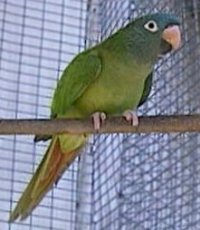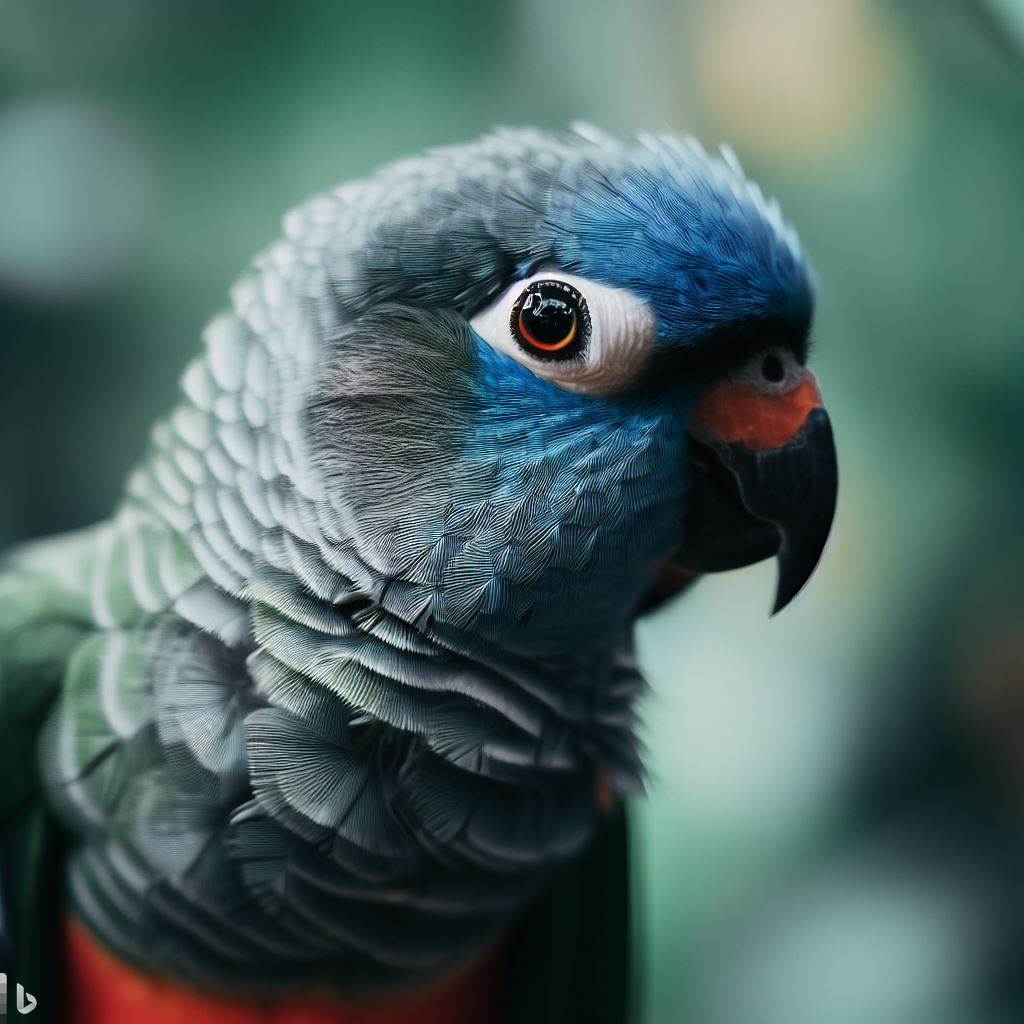
The natural range of Blue Crown Conures extends to several countries in South America that include: Columbia, eastern and south west Brazil, Venezuela, northern Bolivia, Argentina, Uruguay, and Paraguay. In there native habitat Blue Crown’s have been known to allow humans to get quite close. Life expectancy is approximately 30-40 years.
They are one of the larger species of Conures weighing between 150-180 grams. Length from head to tail is appx. 14.5 inches. Coloring is predominately green , with pale olive under the wings. The head, including the forehead, crown, lores, ear coverts and cheeks are dull royal blue. The eyes are surrounded by a bare white patch of skin and the iris is reddish-orange. The upper wing coverts are chestnut-brown, and the tail is green while the lateral tail feather are brownish red with golden olive tips. The upper mandible is horn colored with a black, sharply pointed tip and the lower mandible is solid black. The legs are pinkish grey. Juvenile birds have less of the blue coloration on the head and the mandible is completely horn colored. Although they are not one of the more colorful species of parrot, they more than make up for it with their endearing personality.
As to pet quality, Blue Crowns are exceptional. They are quite friendly, calm, playful, inquisitive, and affectionate. Biting is usually not a problem with the lovable Blue Crowns. They tend to be less nippy than other species of parrots. They can speak with a certain amount of clarity, and they can learn to speak a number of different words and/or phrases. Their intelligence enables them to learn quickly and they can be taught to perform several tricks, such as: sticking out their tongue, waving their foot, kissing, etc. Head scratching and feather preening are a must for a pet Blue Crown. These highly social birds thrive with daily attention. In turn, they will reward you with their companionship.
Instinctively, they like to lay on their backs and play with their feet. They also enjoy hanging from the cage bars by one toe, swinging from their toys. My pairs prefer to sleep hanging in the corners of their cage, or in a sleep box (a sleep box is similar to a nestbox except is has a larger door and plenty of peep holes that provide more light than a nestbox). As with any parrot, especially Aratinga conures, expect a certain of screaming. If a certain amount of screaming would be disruptive to your household, then DO NOT PURCHASE A PARROT! Screaming is a natural part of bird communication. They will call to the other members of the flock, and as a parrot owner, you are part of his/her flock.
If you are considering the purchase of a Blue Crown Conure visit several reputable breeders and pet stores. First observe the bird’s environment looking for cleanliness, ample cage size, varied diet, etc. Interact with the birds and watch how the birds interact with their care giver. Hand fed babies are extremely tame. Even wild caught birds can be tamed rather quickly. Their intelligence can be seen early on and they can be taught to preform tricks. Outfitting a Blue Crown’s cage with natural perches is a must. Those strong beaks enjoy tearing the bark off of the branches. Then they will likely shred the branches into toothpicks. In addition, have an ample supply of wood toys to further enhance their chewing desire. Leather strips are also a favorite. Rotate the toys weekly to prevent boredom. Foot held toys are also relished.
Feeding your Blue Crown a varied diet will contribute to longevity and health. Offer a daily portion of a high quality pellet such as: Hagen, Roudybush, or Harrisons. A daily serving of fresh fruits, vegetables, beans, pasta, and/or bird bread is a must. Fruit seems to be a special favorite among Blue Crowns, especially grapes. My pairs will fill up on the fruits and leave the veggies, so I limit the amount of fruit and I hide it in the bottom of the dish. I also like to serve them a warm mash made up of dark green leafy greens, squash, corn, beans, and other seasonal vegetables and fruits. A small amount of seed or nuts can be offered. Fresh water should be given each day. Blue Crown’s love to bathe in their water dish so I prefer to use water bottles.
Grooming includes regular nail trims around every 6-8 weeks. A cement perch can help keep the talons dull, but are not meant to replace regular nail trims. Remember to check your bird’s wings for new feather growth and have the wings clipped as necessary. Blue Crowns can be given showers using a new spray bottle filled with plain warm water. Most of my Blue Crowns prefer to bathe on their own. I fill a heavy shallow dish with about 2 inches of plain warm water and I put the dish in the sink or inside of their cage. It is delightful to watch them playing in a dish of water. They derived such sheer enjoyment in bathing that I give them the opportunity several times a week. Taking you pet bird in the shower with you can also be enjoyable for your bird and it is a time saver for those busy days. There are several shower perch products out on the market that make showering with your bird more convenient. You can find these products at your local pet store or check out the ads in the parrot magazines.
Daily weighing of your bird is a must. Weight loss is often the first sign the illness, so incorporate a daily weighing into your routine. At the first sign of a weight loss trend……immediately notify your vet. Annual vet checks are also recommended your pet bird(s).
Breeding Blue Crowns may be somewhat difficult. Imported pairs may take a few years to adjust to their surroundings before they feel secure enough to breed. Domestic pairs seem to settle in more quickly. My pairs tend to breed in the spring and summer. The average clutch is 2-4 eggs, and the eggs are laid every third day. My pairs are excellent parents and they will happily feed the babies for the first 3 weeks, at which time, I pull them for handfeeding. My proven pairs will lay more than 2 clutches each year, so I have to remove the nestbox and replace it will a sleepbox after the second clutch. I also reduce the amount of light and food to mimic the dry season. This method has worked well for other species of birds, too.
Having a Blue Crown Conure as part of your household can be quite rewarding, but be sure that you can make the time commitment and provide the necessary care before you purchase a Blue Crown Conure. Making an informed decision and choosing your bird wisely, will ensure that you and your pet will have many happy years together.
A well socialized baby is less likely to have behavioral problems such as excessive screaming, biting, feather plucking etc. Next, look for any signs of illness such as: discharge from the nares, excessive sneezing, labored breathing, abnormal droppings, abnormal feathers, lethargy, underweight, etc. Purchase a WEANED baby bird. Don’t let the reduced cost of an unweaned baby lure you into purchasing one. There is a lot more to raising baby birds than feeding them with a syringe or spoon. It takes years of experience and expertise to successfully raise well adjusted, socialized baby birds. Let your bird benefit from the experience of the professional care giver. A baby bird should be allowed to fledge and learn to fly, and to land with ease, before the first wing clip. Fledging facilitates weaning and builds strong muscles. A bird who hasn’t been given the opportunity to learn to fly and land, is also at risk for injuries caused from improper landings. Ask a lot of questions and expect the care giver to ask you a lot of questions too! Then, choose your bird for it’s personality and disposition, or better yet, let the bird choose you!
The average price of a hand fed baby is around $300.00-$400.00. Regional differences, market availability, and how the bird is raised will impact the price. Remember, you get what you pay for. A pet store or breeder that feeds pellets, fruits & veggies, has large clean cages, offers toys, and spends time socializing the birds, etc. may charge a slightly higher price.
Before you make a deposit, be sure to get a written health guarantee that allows you ample time (2-3 days) to take the bird to an avian vet for a complete check up that should include, a CBC (complete blood count), gram stains, polyoma testing, beak & feather test, and psittacosis testing. It is best to make the vet appointment in advance and pick up your bird just before the appointment. Then, take the bird directly to the vet. You can expect to pay $150.00-$200.00 for the initial vet exam depending on the regional prices in your area.
As with the addition of any new bird, practice strict quarantine practices such as: keeping the new bird in a separate location with a separate air supply, feed and clean the cage last, wash and disinfect dishes daily, and be sure to shower and change your clothing before you come in contact with any of your existing birds. Quarantine should be for a minimum of 45 days, but preferably for 90 days or longer.
Once the decision is made to purchase a Blue Crown, you have to consider the cage and it’s location in the home. Choose a central cage location that offers the bird access to the family. The site should also offer the bird some privacy, natural sunlight, and an area for shade that is free from extreme temperatures such as in the kitchen or near an outside entrance, etc. After the location is decided upon, purchase the largest cage that your budget and space will allow. Safety should be your first consideration. The general construction should be heavy and made from bird safe materials such as: stainless steel, lead & zinc free powder coated finishes, etc. Look for any sharp edges, or parts that may be disassembled by your bird. The entire cage including decorative scroll work , entrance door, and feeder doors, etc.should be thoroughly scrutinize for areas that can trap toes, heads, wings, etc. Bar spacing should be 5/8-3/4 inches apart. The cage should also have a few cross bars that will allow for climbing mobility. Blue Crowns also enjoy playing on the bottom of the cage, so a removable grid will help keep your bird away from droppings and fallen food. Line the tray with plain paper and change it daily. Thoroughly scrub and disinfect the cage weekly.

